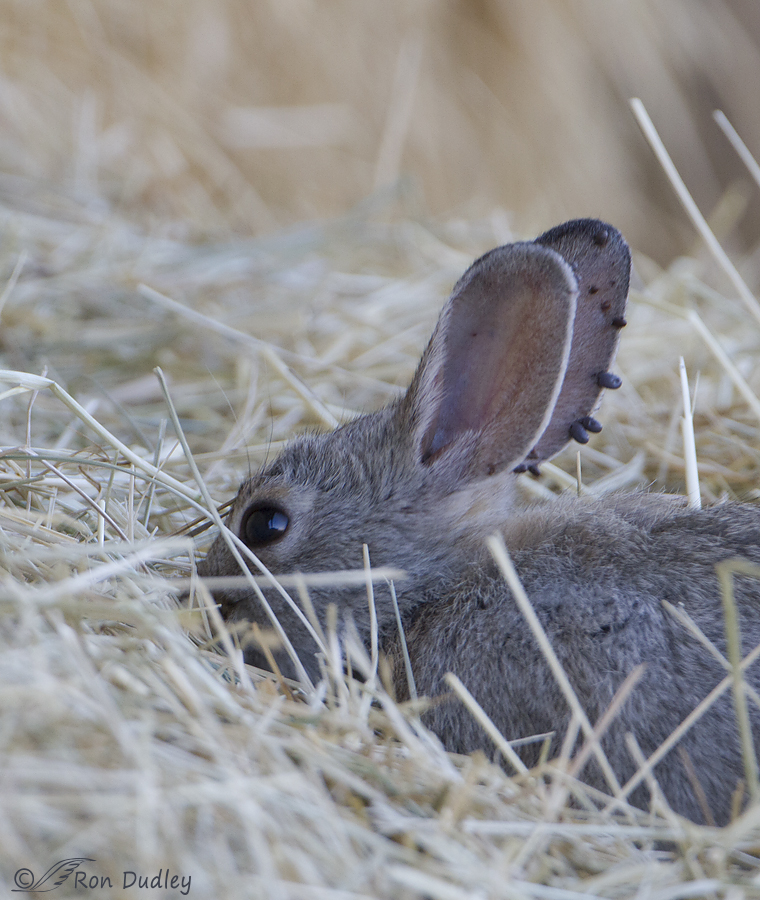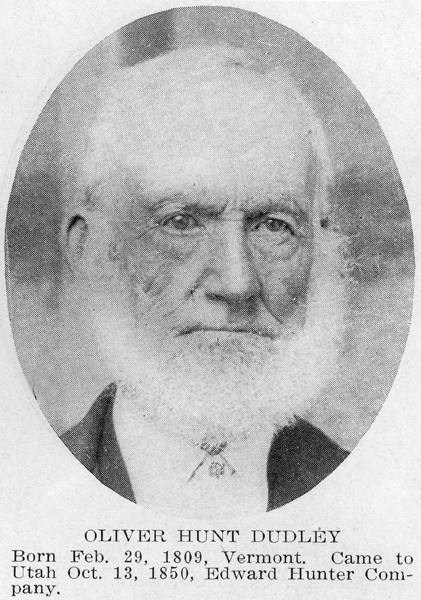Occasionally I rerun a favorite older blog post. This one was originally published in August of 2014. For this version I’ve changed the title, edited the text, cleaned up the formatting and added two photos and the notes at the end of the post.
Rabbits are notorious for having heavy tick infestations. Some of my Mormon pioneer ancestors shared a related fate, as did Brigham Young.

It isn’t unusual for me to see rabbits with many ticks, especially on their ears. I photographed this one near the hay barn on Antelope Island. The ears of rabbits, with less protective hair than the rest of the body, seem to be where most of the ticks congregate. Some rabbits appear to be completely free of them while others are obviously heavily infested.

Here’s another one I found on the island. The inside of its ears also had ticks.
Whenever I see one of these poor tick-infested rabbits I think of my great-great grandparents. I hope you’ll indulge me in a little family history as I explain why.
In the “old west” many early pioneers became seriously ill soon after they reached the foothills of the Rocky Mountains. They thought the mysterious illness was caused by the combination of hot days and cold nights in the mountains so they called it “mountain fever”.
The incidence of illness was high – in some wagon trains as high as 50%. Some died but most did not, though they were extremely ill with wide-ranging symptoms such as chills, muscle and joint pain, headache, deep pain behind the eyes, lumbar back pain, nausea and vomiting.

Image courtesy of Daughters of Utah Pioneers
My great-great grandparents, Oliver and Mary Ann Dudley, were early Mormon pioneers who crossed the plains in wagons from Winter Quarters, Nebraska (near present-day Omaha) to Utah Territory in 1850. During the trip both Oliver and Mary Ann became extremely ill with mountain fever so there were no adults to drive the wagon and their 15 year old daughter (also named Mary Ann) had to drive it more than halfway across the plains, foothills and mountains as her disabled parents rode in the back. I often think of what that experience must have been like for all of them.
Thanks to the research of Jay A. Aldous from the University of Utah (and a few others) we know that “mountain fever” was what we now call Colorado Tick Fever, a disease caused by a virus transmitted by the Rocky Mountain Wood Tick (Dermacentor andersoni). The pioneers rarely rode in their wagons because of the extra load on their animals (besides, those wagons had no springs and it was a jarring experience to ride in one) so everyone walked almost the entire trip. And once they reached the foothills of the Rockies they were largely walking through sagebrush where huge numbers of ticks laid in ambush. In a letter to a friend in 1848 Thomas Bullock wrote (original spelling and punctuation used):
- “(H)ere also commences a five-hundred mile journey through eternal sage plains, from six inches to ten feet high, where the sage is, you must not expect to see any grass, but if you should happen to sit down on a bush, be thanldul if you are not bitten with ‘sage ticks’; they are something like the ticks on cows and very plaguy”.
“Mountain fever” didn’t discriminate when it came to its victims – it even laid Brigham Young low. When he first entered the Salt Lake Valley in July of 1847 he was so ill with mountain fever that he had to be carried in a special wagon to the spot overlooking the valley where he made his famous “This is the place” proclamation.
So yes, when I see ticks on a rabbit in the sagebrush, as I often do on Antelope Island, I think of my ancestors and family history. I’m not Mormon but I have great admiration for those pioneers, Mormon or not, for their toughness, their fortitude and their all-around gumption as they attempted to fulfill their dream of carving out a new life in a remote and hostile land.
Ron
Notes:
- I have documentation for all of the Mormon and family history I’ve included here including old family letters and journals, copies of documents and photos I’ve obtained from the Utah State Historical Society and Daughters of Utah Pioneers and my personal copies of about a half dozen books on Utah and Mormon history.
- Speaking of Oliver Hunt Dudley and (possibly) ticks – he was a shoemaker and tanner by trade and not long after moving to Brigham City from Salt Lake City in the late 1850’s he was permanently blinded in one eye from handling the skins of sheep that had died from some “mysterious disease”. I wonder if that disease could be tick-related. Oliver very nearly died from the illness and one woman (who was holding a lantern while the sheep were skinned that night) did die from it. Every time I look at the above photo of him I think his left eye looks slightly different from the right.
- There’s an error in this post, although this time it isn’t mine. Check out Oliver’s birth date beneath the photo. Can you spot the error before I point it out?

1809 wasn’t a leap year (all leap years are evenly divisible by 4) so how could there be a February 29th? There wasn’t. I’ve visited and taken photos of Oliver’s headstone in the Willard, Utah City Cemetary.

His birth date on the headstone is listed as February 22, 1809.
And yes, Oliver was a Mormon polygamist. He married Hannah later in life, after he and his family arrived in Utah in 1850. I descended from Mary Ann. Oliver and Hannah didn’t have any children.


Fascinating!! Incredible journey.looks like you are making good use of your forced time away from photography.
Thank you for sharing your pioneer ancestors. I’m a descendent of pioneers from the ill-fated Martin Willey handcart company that lost so many members after encountering heavy snow and cold, including my great-great grandfather who succumbed in Wyoming. Two of the boys lost toes and one part of his feet to frost bite. I admire the grit, perseverance and fortitude these pioneers showed in the face of terrible, life threatening odds with little food and freezing temperatures.
Although I am not an active Mormon, I so appreciate my pioneer ancestors. I haven’t been to the Utah Historical Society for information but I will check it out. Thank you.
Late commenting this morning. I suspect that 1809 was not one of the year’s that had a 29th. I have a niece who was born on Feb 29 and I know it occurs every 4 years.
Interesting post. Not being Mormon only have a limited knowledge of their travels and settlements, but yes, what courageous people to have gone through all that to establish themselves in the west. Hard to imagine a 15 year old girl of today enduring anything like she did.
Our golf course rabbits live the life of Reily compared to those bunnies.
Everett, like a lot of folks (perhaps most) back then my ancestors were incredibly tough. They had to be. When I read their letters and journals I’m literally in awe of many of the things they endured.
Minor correction (good for trivia games): Not every year that’s divisible by 4 is a leap year. Century years are normally not leap years; only century years that are divisible by 400 are leap years. So 2000 was a leap year, but 1800 (for example) was not, and 2100 will not be (if we’re still on the Gregorian calendar by then).
Interesting Phil, although as far as I can tell what I said is still correct. All I said was that “all leap years are evenly divisible by 4” and they are. I didn’t say that every year that is divisible by 4 is a leap year. Or am I missing something?
Ron, what you said was correct. I was commenting on Everett’s statement that “it occurs every 4 years.”
In any case, your post was very interesting, and I hope your back is improving.
And ticks still kill people and/or make them very sick.
Love reading about your ancestory – something which is a total mystery to me.
I wonder how many of our current generations would survive if we were forced to do a similar march with no more equipment. Not many I suspect.
I continue to send healing wishes your way. By the truckload.
I agree EC, probably not many. And probably not me, even when I was younger.
Thanks for the good wishes. This is turning out to be an incredibly slow recovery. The surgery was two weeks ago yesterday and I still feel like I’ve been hit by a freight train.
Not me either. Not younger me or the current decrepit version.
Hugs and hopes are wending their way across the miles to you.
if it helps any, I had surgery two weeks ago on the 26th, myself, and had been given the expectation from another who’d had the same surgery, that I would be up and not even knowing I’d had surgery three days later. Here I am two weeks later, still with significant pain, an allergic reaction to every single pain med we’ve tried, and feeling incredibly frustrated…. I’m so sorry for your experience, may we both heal quickly from here on out…..
Fascinating story, Ron. I love how you make connections between seemingly disparate subjects.
The family resemblance is unmistakable between you and your g-g-grandfather, although his hard life is certainly etched into his appearance.
I wonder if tularemia could have caused both the woman’s death and Oliver’s strabismus. It, too, has a tick, among other arthropods, as a vector. I think you meant Dermacentor andersoni?
I imagine those headstones could get quite crowded, depending on the number of wives.
Speaking of ancestors, I had my DNA analyzed a few years ago. Other than the obvious Neanderthal component, I was astonished at how different my genetic code was at odds with what my parents told me. May or may not have involved polygamy, but there had to be a whole lot of messin’ around goin’ on. Who knew I was 0.5% Northern Chinese/Tibetan?
You’re right, Lyle – it should be Dermacentor andersoni. I’ve made the correction. Thanks for the heads up.
I keep meaning to have my DNA analyzed and maybe I still will. But my sister had hers done and I know her results so my motivation for doing it took a hit.
Ewwwwww!
Poor bun-buns. They could use some helpful crow friends like these wallabies have: https://www.youtube.com/watch?v=TfDSBrsVGx8
Always enjoy a good story out of the Annals of Dudley and this one certainly didn’t disappoint! You’re definitely made from tough stock, Ron, as is Shannon. Glad you were feeling up to posting this morning and hope your healing continues quickly.
Dang, those are some HUGE ticks on those wallabies, Marty. Thanks for providing the link.
Some of the later videos in the series are even worse! This was the “tamest” of them. Mutualism is fascinating (even if the wallabies don’t seem all that thrilled with it at first).
As the keeper of our family records, I appreciate a good family history story. Years ago I raised Beagles and was always picking ticks off them. Lyme Disease is carried by Deer Ticks here in New England and is a very dibilating disease. Those poor rabbits !! .
Poor rabbits indeed. Thanks, Gary.
What a rich post Ron. Lots to muse on. I think that chickens might like ticks but I can’t think of anyone else. Miserable creatures. And hide tanning – a difficult task and often (particularly now I think) associated with toxic chemicals. I don’t think that animals want their hides to be turned into leather or clothes … and – you are blessed with tough genes
Thank you, Frances. As of late, my supposed “tough” genes have been put to the test.
Interesting even if the thought of ticks makes my skin crawl! Before you mentioned Colorado Tick Fever, Rocky Mountain Spotted Fever came to mind. Always interesting how some folks seem to be “tick magnets”(a couple of my siblings) and others (me) not so much.
Before you mentioned Colorado Tick Fever, Rocky Mountain Spotted Fever came to mind. Always interesting how some folks seem to be “tick magnets”(a couple of my siblings) and others (me) not so much.
A few years back a Whitetail Deer in the area had them so bad it died. Until then I was unaware that ticks could/would do that!
Judy, moose in particular have a big problem with ticks. In some years, in some areas, their mortality from ticks is quite high.
Those poor rabbits. Makes me shudder to look at their ears. The various
subtle miseries of Lyme disease ( borne by ticks of other species ) are being newly understood practically day by day…. makes me wonder what function
in their ecosystem that ticks play, evolutionarily ?
Kris, my big ears would make a huge playground for ticks so I’m glad they haven’t been a problem for me…
I’m not normally squeamish, but, yes, those photos put me off my breakfast. Worse than the vultures or coyotes on carcasses.
Sorry about your breakfast, Cheryl.
Thanks for sharing Ron. I love hearing these stories, and I’ve enjoyed researching and writing about the roots and stories of my own family. A big part of this is finding appreciation for what we have today as a result of their efforts. It’s a wonder; all that they endured and built.
I know this is a bird blog, but I welcome a good ancestry story anytime.
I’m glad you enjoyed it, Michael. Almost from the get-go I haven’t strictly limited the subjects I cover on my blog to birds.